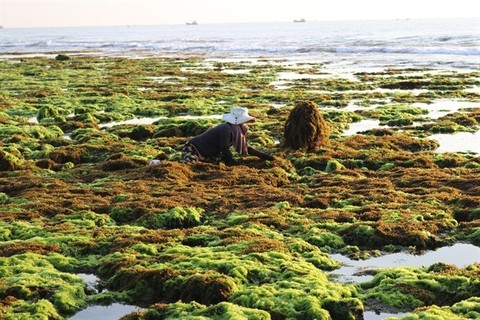
Local fishermen collect certain types of seaweed. Seaweed offers a lucrative opportunity to generate income through carbon credit sales. — VNA/VNS Photo
Just as the forestry sector has tapped into the carbon credit market, the aquaculture sector, particularly seaweed farming, is emerging as a promising avenue with the potential to store up to 1,500 tonnes of greenhouse gas per square kilometre.
Việt Nam has identified 800 species of seaweed, of which 90 have economic value. Currently, the country has large-scale seaweed farming areas, which are often integrated with other seafood and marine products like oysters, pearls and abalones.
Đinh Xuân Lập, Deputy Director of the International Collaborating Centre for Aquaculture and Fisheries Sustainability (ICAFIS) under the Việt Nam Fisheries Society, said that both domestic and international scientists had proven that seaweed can absorb CO2 two to five times more effectively than forests of the same area.
Some species, including kelp with broad fronds, can absorb CO2 up to 20 times more efficiently than trees. Expanding seaweed farming will therefore create massive carbon storage capability for the seafood industry.
“We are collaborating with businesses to develop the Blue Ocean-Blue Foods programme to grow Việt Nam’s seaweed areas, turning them into CO2 absorption reservoirs,” Lập said.
The goal is to develop large-scale seaweed farming to mitigate the effects of climate change, reduce greenhouse gas emissions, improve the marine environment and enhance community livelihoods.
Meanwhile, companies are now producing biodegradable plastic cups from seaweed. Việt Nam’s seaweed also has an advantage in pharmaceuticals compared to countries like Japan and South Korea.
"Seaweed from Việt Nam can be processed into various compounds used in dentistry or the food industry, such as in dairy products to create thickness and blend in milk. The extract yields are much higher than those from seaweed we tested from Japan and South Korea," Nguyễn Thị Sâm, CEO of Wineco Việt Nam JSC, stated.
Moreover, after being processed for cosmetics and pharmaceuticals, the residue from some seaweed species can be used as animal feed, helping to reduce methane emissions from livestock.
The agricultural sector has identified seaweed as a green resource that helps clean the seas and the atmosphere while providing a good income for farmers, given the relatively low investment costs.
In large seafood farming areas, including Quảng Ninh, Khánh Hòa, Ninh Thuận and Kiên Giang, seaweed farmers can earn billions of VNĐ annually, providing a livelihood that helps many households escape poverty.
According to a report by the Directorate of Fisheries under the Ministry of Agriculture and Rural Development, Việt Nam’s potential seaweed farming area could reach around one million hectares, yielding 600,000 to 700,000 tonnes of dry seaweed annually.
Currently, Việt Nam’s seaweed production stands at around 150,000 tonnes per year. Trần Đình Luân, Director of the Directorate of Fisheries, believes that once seaweed farming reaches a certain scale, Việt Nam will collaborate with international organisations to enable seaweed farmers to sell carbon credits.
“Globally, carbon credits from seaweed farms have already been discussed. In Việt Nam, selling carbon credits from seaweed is also very feasible,” he said.
With countries committing to reducing greenhouse gas emissions, carbon credits represent a highly promising market, expected to reach up to $100 billion by 2030.
In Việt Nam, forest carbon credits have already been successfully transferred at $5 per credit. The World Bank has committed to paying $10 per credit for rice carbon credits. Meanwhile, some international organisations have expressed interest in purchasing carbon credits at prices of $20-30 per credit.
According to the latest draft of the Carbon Market Development Scheme in Việt Nam, from 2025-2028, the carbon market will be piloted nationwide. From 2029 onwards, the market will be officially operational nationwide.
By expanding seaweed cultivation to its full potential of around one million hectares, the aquaculture sector can unlock a vast source of blue carbon credits. Once the carbon market is operational, seaweed carbon reservoirs will become a new resource, helping Vietnamese fishermen increase their income. — VNS